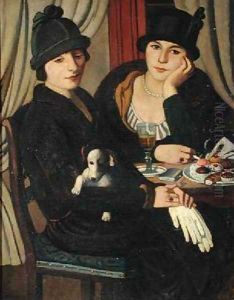Pietro Marussig Paintings
Pietro Marussig was an Italian painter associated with the Modernist movement, particularly known for his contributions to the development of Italian Divisionism and later, metaphysical painting. Born on July 18, 1879, in Trieste, which was at the time a part of the Austro-Hungarian Empire, Marussig developed his artistic skills in an environment rich with cultural influences.
Initially, Marussig trained at the Accademia di Belle Arti in Venice, where he was influenced by the prevailing styles of the time. His early works were in line with the Divisionist technique, characterized by the use of distinct strokes of color intended to blend in the viewer’s eye, creating a luminous effect. This approach was an Italian counterpart to the more widely known pointillism, and it was a response to the scientific interests in optical effects and color theory that were prevalent at the end of the 19th century.
As Marussig’s style evolved, he became involved with the Italian avant-garde and was influenced by Symbolism and later, Futurism, though he never formally joined the Futurist movement. His work during this period begins to reflect a more dynamic approach to composition, with an emphasis on movement and modern life, which were key themes in Futurism. However, Marussig's aesthetic was more nuanced and less politically charged than that of the leading Futurists.
During World War I, Marussig served in the Italian army, an experience that had a profound impact on his life and work. After the war, he moved to Milan and became associated with the Novecento Italiano movement, which sought to create a new classicism in Italian art, drawing inspiration from Italian masters of the Renaissance and Baroque while incorporating contemporary sensibilities.
Marussig’s later works showcase a shift towards metaphysical painting, a style that was becoming popular among certain Italian artists in the post-war period, including Giorgio de Chirico. This movement was characterized by dreamlike scenes with strange, eerie atmospheres, often including classical architecture, long shadows, and a general sense of stillness and contemplation.
Pietro Marussig continued to exhibit his work throughout Italy and Europe during his lifetime. He participated in the Venice Biennale several times and had his works displayed in various important exhibitions. Marussig's artistic journey reflects the tumultuous transitions and innovations in the art world during the early 20th century, as he adapted and contributed to various movements and styles throughout his career.
Marussig passed away on May 26, 1937, in Milan. Today, his works can be found in numerous art collections, both in Italy and internationally, where they serve as examples of the vibrant and changing art scene in Italy during the late 19th and early 20th centuries.
